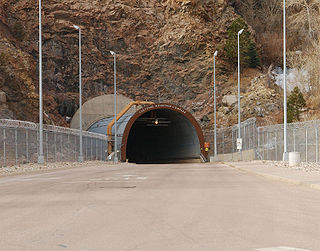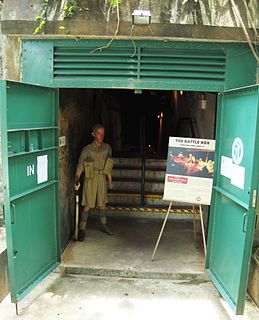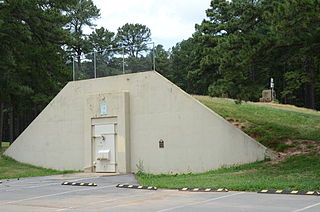 W
WA bunker is a defensive military fortification designed to protect people and valued materials from falling bombs or other attacks. Bunkers are mostly underground, in contrast to blockhouses which are mostly above ground. They were used extensively in World War I, World War II, and the Cold War for weapons facilities, command and control centers, and storage facilities. Bunkers can also be used as protection from tornadoes.
 W
WA casemate is a fortified gun emplacement or armored structure from which guns are fired. Originally, the term referred to a vaulted chamber in a fortress. In armoured fighting vehicles that do not have a turret for the main gun, the structure that accommodates the gun is termed the casemate.
 W
WThe Regelbau were a series of standardised bunker designs built in large numbers by the Germans in the Siegfried Line and the Atlantic Wall as part of their defensive fortifications prior to and during the Second World War.
 W
WThe Battle Box is the popular name of the Fort Canning Bunker, formerly known as Headquarters Malaya Command Operations Bunker, constructed under Fort Canning Hill, Singapore, as an emergency, bomb-proof command centre during the Malayan Campaign and the Battle of Singapore. The Battle Box is currently a museum and tourist attraction.
 W
WDetachment Hotel is the name used to refer to a small 1,500-square-foot (140 m2) bunker complex on Peanut Island, Florida. It was originally designed for use by the President of the United States, specifically John F. Kennedy, in the event of a nuclear war. Constructed in 1960, the bunker was closed less than three years later, and its existence was declassified in 1974. From 1998 to 2017, it was open to the public as an historic site.
 W
WThe Hospital in the Rock Nuclear Bunker Museum is the name given to a hospital created in the caverns under Buda Castle in Budapest in the 1930s, in preparation for the Second World War.
 W
WThe Matsushiro Underground Imperial Headquarters was a large underground bunker complex built during the Second World War in the town of Matsushiro, which is now a suburb of Nagano, Japan. The facility was constructed so that the central organs of government of Imperial Japan could be transferred there. In its construction, three mountains that were symbolic of the Matsushiro municipality were damaged.
 W
WThe Maumelle Ordnance Works Bunker No. 4 is a historic munitions storage facility at 4 Willastein Drive in Maumelle, Arkansas. It is a concrete structure, 61 by 27 feet, with a rounded roof and ventilation stack. It is covered with earth, with a trapezoidal concrete side wall exposed, which has a steel door at its center. The bunker was built in 1941-42 to store the explosives picric acid and ammonium picrate for use during World War II. Of 21 built in Maumelle, all but three have been demolished, and this is the only one that is entirely intact.
 W
WRubber room is the nickname given to the emergency egress bunkers located 40 feet (12 m) beneath the launch pads at Kennedy Space Center Launch Complex 39; there is one below each of the two pads. Built in the 1960s for the Apollo program, and intended to provide a safe refuge for personnel on the launch pad in the event of an imminent explosion of the rocket, when a rapid egress of the pad is required and the normal evacuation methods would take too long. The bunker was designed to withstand the explosion of a fully fueled Saturn V rocket on the pad above, and could support up to 20 people for 24 hours.
 W
WA submarine pen is a type of submarine base that acts as a bunker to protect submarines from air attack. The term is generally applied to submarine bases constructed during World War II, particularly in Germany and its occupied countries, which were also known as U-boat pens.
 W
WThe Cold War Museum (Moscow) or Bunker GO-42, also known as "facility-02" (1947), CHZ-293 (1951), CHZ-572 (1953), and GO-42, and now Exhibition Complex Bunker-42, is a once-secret military complex, bunker, communication centre in Moscow, Russia, near the underground Moscow Metro station Taganskaya. It has an area of 7,000 square metres (75,000 sq ft) and is situated at a depth of 65 metres (213 ft) below ground.
 W
WWest Fort Hood is an underground weapons storage area adjacent to Fort Hood in Texas. Originally built in the late 1940s by the United States Air Force, it was adjacent to Gray Air Force Base. On 15 June 1963 Killeen Base was turned over to the Army, and in October 1969, Killeen Base was designated as West Fort Hood and the airfield's name was designated as Robert Gray Army Airfield. It is also home to the Army Operational Test Command.